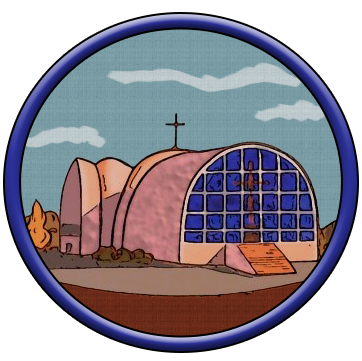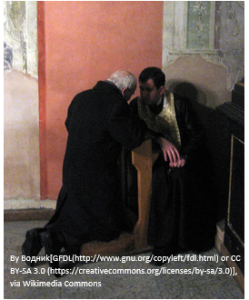Mysteries of Healing
The Mystery of Repentance
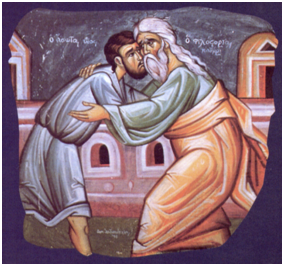 Christ has given us a way by which He can touch us with His saving hand. It is through the Holy Mystery of Repentance, also known as the Sacrament of Confession.
Christ has given us a way by which He can touch us with His saving hand. It is through the Holy Mystery of Repentance, also known as the Sacrament of Confession.
Regretfully, the reception of this sacrament not used as often as it should. Perhaps it is because of great misunderstanding of what it is. It may also be due to poor catechizing in the past and present. It is an area, which requires within our Churches a great deal of teaching and re-newal.
We call it a mystery of forgiveness and healing maybe the word “confession” has given this Sacrament a negative note. Perhaps we need to call it by its proper name: “The Mystery of Repentance”. The whole meaning of the Mystery is seen in the parable of the Prodigal Son-the open outstretched hand of a welcoming father. It welcomes, forgives and heals. It is not so much as what we do, as it is what Christ does for us. St. John Chrysostom wrote: “let us apply ourselves to the saving remedy of repentance: let us accept from God the repentance that HEALS us. For it is not we who offer it to Him, but He who bestows it upon us.” Note the emphasis on the word “heals”.
Yes, in this Mystery, Christ lifts us up from the depths into which we may have fallen. Just as important, Christ the Divine Physician re-stores what is broken, wounded within us. This Sacrament is medicine for our souls. The Divine Physician restores what is broken within us. He takes our heavy burdens. It is here where He refreshes us. So this Sacrament is much more then just an absolution. It is the place where we can open our soul’s wounds. We come to Christ, the Hope of the hopeless.
Unfortunately, our Church needs to do some serious teaching of the necessity of the Sacrament. It is not just a “duty” to be done once a year. How can it be a “duty” to come to the Divine Physician only once a year? This is totally inadequate. It must become much more then a minimized three to five minute recitation of sin with a line of penitents waiting to fulfill their “Easter Duty”. This as a very serious area which needs to be rediscovered in the spiritual life of our Church. This Sacrament with the Mystery of the Body and Blood of Christ must be the focal point of our lives as Christians.
Repentance Guide for Youth and Young Adults
Adapted from: stjosephukr.com/mysteries/reconciliation
For a more comprehensive explanation see: The Catechism of the Ukrainian Catholic Church: Christ Our Pascha pg 153-157.
Mystery of the Anointing of the Sick
When one is ill and in pain, this can very often be a time of life when one feels alone and isolated. The Sacrament of the Anointing of the Sick reminds us that when we are in pain, physical, emotional, or spiritual, Christ is present with us through the ministry of His Church. He is among us to offer strength to meet the challenges of life, and even the approach of death.
As with Chrismation, oil is also used in this Sacrament as a sign of God’s presence, strength, and forgiveness. Christ came to the world to “bear our infirmities.” One of the signs of His divinity was to heal the sick. The power of healing remains in the Church since Christ himself remains in the Church through the Holy Spirit.
The Church has always viewed body and soul as inseparable thus stressing the necessity for preserving both in good health, following Jesus Christ’s exhortation to his disciples to “heal the sick, cleanse the lepers, raise the dead, cast out demons” (Matthew 10:10). This follows Christ’s ministry to “heal the broken hearted, and to proclaim liberty to the captives and recovery of sight to the blind” (Luke 4:18; see Is 61:1), and to heal “all kinds of sickness and all kinds of disease (Matt. 4:23).
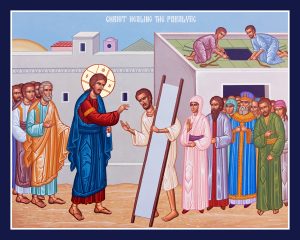
By the hand of Father Luke Dingman, www.lukedingman.com/
In healing, the Church follows the procedure prescribed by the Apostle James: “Is anyone among you sick? Let him call for the elders of the church and let them pray over him, anointing him with oil in the name of the Lord. And the prayer of faith will save the sick, and the Lord will raise him up. And if he has committed sin, he will be forgiven” (James 5:14-15).
James here speaks of a priestly anointing with oil that leads to the physical and spiritual healing of a person, through the prayer of faith. This sacred action has become a Mystery (sacrament) of the Church and is known as Holy Unction meaning prayer oil). The Holy anointing is given to all who are sick, and not restricted to the dying. The dying are usually given Holy Communion, as a preparation for death.
The Service
During the sacrament, the grace of God is entreated upon a person to heal their infirmities of body and soul while the body is anointed with oil. The efficacy of the sacrament depends upon the promise and appointment of God; however it benefits only those who receives it with a ‘prayer of faith’, and with due preparation and disposition of mind. The final prayer is for remission of sins:
“And if (Name) has committed sins and transgressions, grant remission and forgiveness, because You love mankind”. It is the clear intention of the Sacrament that through the anointing of the sick body the sufferings of the person should be sanctified and united to the sufferings of Christ. In this way, the wounds of the flesh are consecrated, and strength is given that the suffering of the diseased person may not be unto the death of his soul, but for eternal salvation in the resurrection and life of the Kingdom of God.
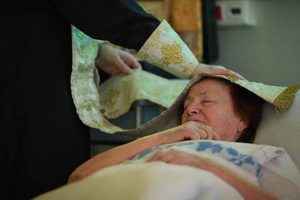
Photo by Deacon Andriy Radkewych / nsad.ru
As orthodox Christians we pray, neither commanding God to heal nor doubting His ability to heal, but pleading for His promised mercy upon all who are ill.
Adapted with appreciation from:
Understanding the Sacraments of the Orthodox Church by Rev. Fr. Thomas Fitzgerald at goarch.org/-/the-sacraments
stjosephukr.com/mysteries/unction/
For a more comprehensive explanation see: Catechism of the Ukrainian Catholic Church: Christ Our Pascha pages 157-159.
